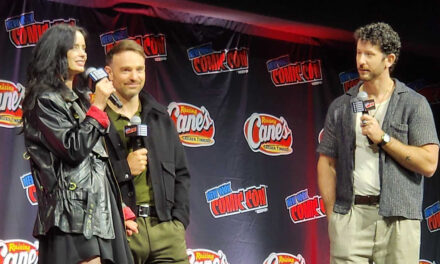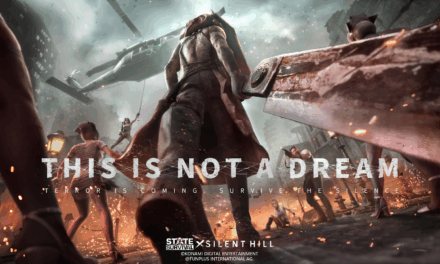Doctor Who delivers its most Black Mirror episode yet in season 14’s ‘Dot and Bubble’. The episode centers on a place called Finetime; a bright-colored and seemingly idyllic place that isn’t quite as harmonious as it first seems.
Finetime is like Balamory for TikTokers; it is harshly bright, with every inhabitant being a blonde, blue-eyed young influencer. They all walk around in the Bubble, a social media VR headset-like device that means they aren’t fully in tune with the world around them.
We meet Lindy Pepper Bean (Callie Cooke), who spends her days interacting with her friends on social media; following heartthrob singer Ricky September, and working in an office job for just two hours a day. With her peppy speech pattern, insincere concern about the world, and self-absorption, she is the archetype of every influencer.
Her social media is intercepted by The Doctor (Ncuti Gatwa) and Ruby (Millie Gibson), who drop her a message warning her that her friends are mysteriously going missing. It’s reminiscent of the iconic ‘Blink’ where Tennant’s Doctor delivered messages to Sally via a TV screen. Lindy ignores their warnings and her many friends’ offline status to carry on her online life. It’s not so subtly depicting the way many people ignore the horrors of the world and seek comfort in their own corner of the internet.
Lindy panics when she is asked to put down her Bubble to help The Doctor and Ruby, who can’t enter Finetime. She can’t walk without her Bubble pointing her way and struggles to see the world as it actually is, not the augmented reality she is accustomed to. It mirrors those people who drive their cars into quays because they blindly follow their satellite navigation system.
![Doctor Who 'Dot and Bubble' - BBC Show Goes A Bit Black Mirror [Review]](http://thathashtagshow.com/wp-content/uploads/2024/05/Doctor-Who-Dot-and-Bubble-Lindy.jpg)
Another Doctorlite Episode
It’s another The Doctorlite episode, with timelord and Ruby appearing on her social media in video form through the majority of the episode. This is the second episode that The Doctor barely features after ’73 Yards.’ It’s an interesting choice to have a new The Doctor so out of action in his debut season. The order of the 14th season feels slightly unbalanced. It delivers two lighthearted episodes followed by two more serious and then two that barely feature The Doctor.
It feels like audiences still don’t quite understand this new regeneration or what makes him tick. After ‘Boom’, it’s clear that Gatwa can handle whatever the writers have; so sidelining the actor for two episodes is an odd production choice. Whether this is deliberate or simply a scheduling issue, his absence is felt once more in the episode.
There will obviously be Black Mirror comparisons, and Russell T. Davies knows that. The showrunner has openly admitted that this is the “clearest step into Black Mirror”. The concept of a world obsessed with social media is reminiscent of Black Mirror’s ‘Nosedive’, which starred Bryce Dallas Howard as a woman obsessed with her personal rating. ‘Dot and Bubble’ never quite goes to the dark satire of the Netflix drama but instead blends the campy Monster of The Week trope with the fear of technology. The satire of this episode could have been pushed even further, and the monster aspect could have also gone further.
![Doctor Who 'Dot and Bubble' - BBC Show Goes A Bit Black Mirror [Review]](http://thathashtagshow.com/wp-content/uploads/2024/05/478841-fd632e8-1024x683.jpg)
An Explosion Of Colour
‘Dot and Bubble’ is one of the more forgettable episodes of the season. It looks great, an explosion of bright pastel colors and loud noises, like Lazytown dialed up to 11. The set design and production values are once again elevated from previous seasons. The bright world of Finetime, matched with the Scooby-Dooesque pastel costumes, gives the episode an uncanny atmosphere from the opening scene.
There is a lot of fantastic satire on the young people’s blind following of social media and the idea that underneath the surface the world of influencers is not as idyllic as they seem. Nothing about ‘Dot and Bubble’ feels particularly original in its concept or its visuals. This idea of people blindly following social media and ignoring the real perils of their real life has been tread on before. This is a brighter, more tongue-in-cheek take on it, which is refreshing after the last two weeks of intense drama.
The set-up and world-building are where the episode excels. The actual mystery and monster side of the episode is less effective. The lack of jeopardy in the episode makes it feel more like it comes from Davies’ original run rather than this bigger, scarier reinvention of Doctor Who. Although the supernatural elements of the episodes are entirely forgettable, a last-minute twist chillingly showcases that humanity is always the biggest threat to the world.
The idea for ‘Dot and Bubble’
The idea for ‘Dot and Bubble’ was originally pitched during the Moffatt era of Doctor Who. But the show didn’t have the budget 15 years ago. The concept has only become more relevant since, with the world struggling to live in reality without being plugged into tech 24/7. It also has been overdone since it was first pitched in connection to Matt Smith’s The Doctor and Amy Pond.
Russell T. Davies is clearly having a ball mixing real-world issues into the fun of Doctor Who. This investigation into the perils of choosing to exit real life in favor of social media follows last week’s terrifying pro-nuclear war prime minister; ‘the depiction in Boom‘ of the capitalism of war, and ‘Space Babies’ commentary on refugees and pro-lifers. It’s a shame The Doctor doesn’t have more to do in his opening series.
For more updates on Doctor Who, check back to THS.

![Doctor Who ‘Dot and Bubble’ – BBC Show Goes A Bit Black Mirror [Review]](https://www.thathashtagshow.com/wp-content/uploads/2024/05/dr-who-2-1280x640.jpg)


